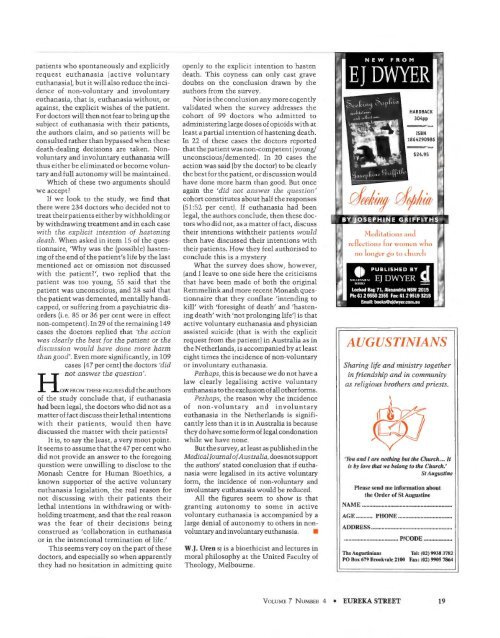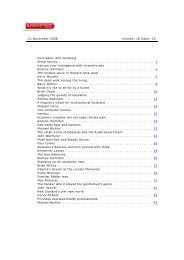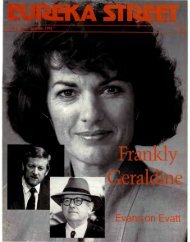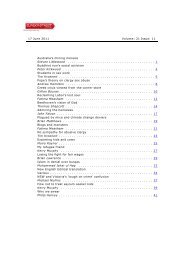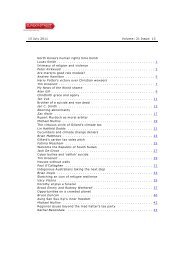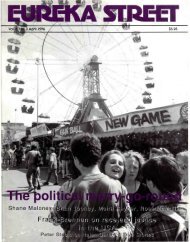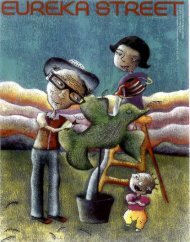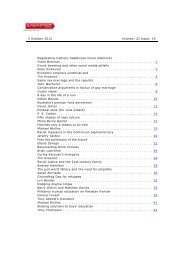n - Eureka Street
n - Eureka Street
n - Eureka Street
You also want an ePaper? Increase the reach of your titles
YUMPU automatically turns print PDFs into web optimized ePapers that Google loves.
patients who spontaneously and explicitlyrequest euthanasia (active voluntaryeuthanasia), but it will also reduce the incidenceof non-voluntary and involuntaryeuthanasia, that is, euthanasia without, oragainst, the explicit wishes of the patient.For doctors will then not fear to bring up thesubject of euthanasia with their patients,the authors claim, and so patients will beconsulted rather than bypassed when thesedeath-dealing decisions are taken . Nonvoluntaryand involuntary euthanasia willthus either be eliminated or become voluntaryand full autonomy will be maintained.Which of these two arguments houldwe accept?If we look to the study, we find thatthere were 234 doctors who decided not totrea t their patients either by withholding orby withdrawing treatment and in each casewith the explicit intention of hasteningdeath. When asked in item 15 of the questionnaire,'Why was the (possible) hasteningof the end of the patient's life by the lastm entioned act or omission not discussedwith the patient?', two replied that thepatient was too young, 55 said that thepatient was unconscious, and 28 said thatthe patient was demented, mentally handicapped,or suffering from a psychiatric disorders(i.e. 85 or 36 per cent were in effectnon-competent). In29 of the remaining 149cases the doctors replied that 'the actionwas clearly the best for the patient or thediscussion would have done more harmthan good'. Even more significantly, in 109cases (47 per cent) the doctors 'didnot answer the question'.HOW FROM THESE FIGURES did the authorsof the study conclude that, if euthanasiahad been legal, the doctors who did not as amatter of fact discuss their lethal intentionswith their patients, would then havediscus ed the matter with their patients?It is, to say the least, a very moot point.It seems to assume that the 47 per cent whodid not provide an answer to the foregoingquestion were unwilling to disclose to theMonash Cen tre for Human Bioethics, aknown supporter of the active voluntaryeuthanasia legislation, the real reason fornot discussing with their patients theirlethal intentions in withdrawing or withholdingtreatment, and that the real reasonwas th e fear of th eir decision beingconstrued as 'collaboration in euthanasiaor in the in tentional termination of life.'T his seem s very coy on the part of thesedoctors, and especially so when apparentlythey had no hesitation in admitting quiteopenly to the explicit intention to hastendeath. This coyness can only cast gravedoubts on the conclusion drawn by theauthors from the survey.Nor is the conclusion any more cogentlyvalidated when the survey addresses thecohort of 99 doctors who admitted toadministering large doses of opioids with atleast a partial intention of hastening death.In 22 of these cases the doctors reportedthat the patient was non-competent (young/unconscious/demented). In 20 cases theaction was said (by the doctor) to be clearlythe best for the patient, or discussion wouldhave done more harm than good. But onceagain the 'did not answer the question'cohort constitutes about half the responses(51 :52 per cent). If euthanasia had beenlegal, the authors conclude, then these doctorswho did not, as a matter of fact, discusstheir intentions withtheir patients wouldthen have discussed their intentions withtheir patients. How they feel authorised toconclude this is a mysteryWhat the survey does show, however,(and I leave to one side here the criticismsthat have been made of both the originalRemmelin k and more recent Monash questionnairethat they conflate 'intending tokill' with 'foresight of death' and 'hasteningdeath' with 'not prolonging life') is thatactive voluntary euthanasia and physicianassisted suicide (that is with the explicitrequest from the patient) in Australia as inthe Netherlands, is accompanied by at leasteight times the incidence of non-voluntaryor involuntary euthanasia.Perhaps, this is because we do not have alaw clearly legalising active voluntaryeuthanasia to the exclusion of all other fom1s.Perhaps, the reason why the incidenceof non-voluntary and involuntaryeuthanasia in the Netherlands is significantlyless than it is in Australia is becausethey do have some form of legal condonationwhile we have none.Bu t the survey, at least as published in theMedical fomnal of Australia, does not supportthe authors' stated conclusion that if euthanasiawere legalised in its active voluntaryfonn, the incidence of non-voluntary andinvoluntary euthanasia would be reduced.All the figures seem to show is thatgranting autonomy to some in activevoluntary euthanasia is accompanied by alarge denial of autonomy to others in nonvoluntaryand involuntary euthanasia. •W.J. Uren SJ is a bioethicist and lectures inm oral philosophy at the United Faculty ofTheology, Melbourne.AUGUSTINIANSSharing life and ministry togetherin .friendship and in communityas religious brothers and priests.'You and I are nothing but the Church ... Itis by love that we belong to the Church.'St AugustinePlease send me information aboutthe Order of St AugustineNAME ........................................................... .AGE ........... PHO E ................................. ...ADDRESS ..................................................... ..................................... P/CODE .................. .The Augustinians Tel: (02) 9938 3782PO Box 679 Brookvale 2100 Fax: (02) 9905 7864V oLUME 7 NuMBER 4 • EUREKA STREET 19


